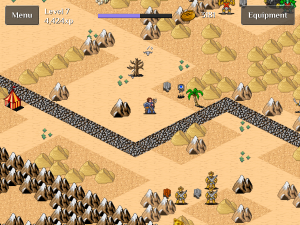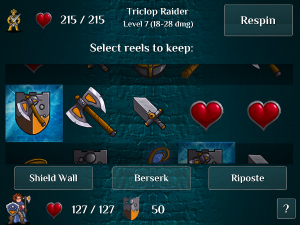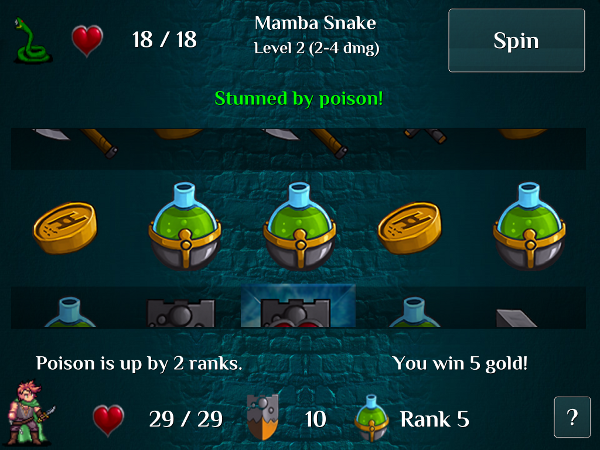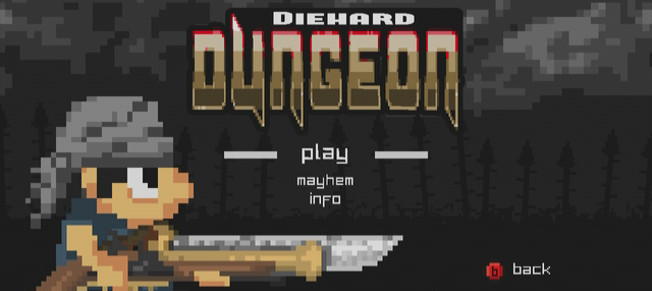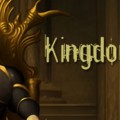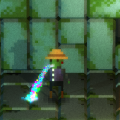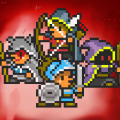I believe developers have three choices when creating a new game. Although quite rare these days, sometimes they’re able to create something entirely new and unique. More often, inspiration from games that have come before lead to new twists and takes on an industry standard. However, it’s the third option that interests me for an entirely different reason. It’s the blending of two or more completely different game types. Some, like the creators of Puzzle Quest or Wizorb manage to succeed at making the hybridization such a seamless fit that we wonder why it ever seemed so strange. In iOS title Dungeon Plunder, developer Dominic Duchesne took a stab at mixing two wildly different types of games and comes away with something of a success story of his own.
Dungeon Plunder melds some common traits of roguelikes with the universally-understood gameplay mechanics of a slot machine. The game is framed by an overworld consisting of typical RPG environments like grasslands, deserts, and ice fields. Stationary enemies are scattered across the landscape and when contacted will initiate a battle with the player (more on that later). Although there’s not much in the way of direction for the player, it’s easily understood to keep fighting and following the main path. Stores are strategically placed for the player to purchase combat equipment and to sell off any loot picked up. There are also stations set up that challenge the player to kill x number of a certain enemy type. Successfully completing that quest and returning to the station will earn the player a large experience and money boost. Dungeons can also be found which often contain a larger amount of loot being guarded by tightly-grouped enemies.
I didn’t actually find the overworld very interesting. Even though the game technically has a story, it’s definitely not a driving force. The quests – although beneficial to the player – don’t really do anything to develop the world and the people within it. Even though it’s understood that everything’s gone to ruin, the lack of people and interactions make the world feel like an empty shell. The music, however, does add a bit of atmosphere and the developers have seen fit to offer the soundtrack separately through iTunes.
What will keep the player coming back is the addictive nature of the game’s combat system. There are the usual staples of an RPG fight like hit points and defense that need to be considered at all times. How the fight is conducted is anything but conventional. There’s a five-reel slot machine, and each round the player can spin the reels twice. The images that appear represent attacks, defensive bonuses, money, and other boosts. In between spins, the player can lock as many of the reels as he or she wishes before spinning the others. The more of the same image that appear, the higher the benefit received for that attribute. It’s also possible to receive multiple boosts in a single round. At the end of each round, the enemy gets their chance to attack. Most of their moves are simple physical attacks that may or may not be partially blocked depending on the player’s stats. Thankfully, version 1.15 of the game recently added special abilities to the enemies to add some diversity. The idea of repeatedly playing a slot machine might not sound interesting to those who aren’t compulsive gamblers, but the strategic appeal is taken to new heights when the player’s character class is taken into account.
Dungeon Plunder includes three character classes for players to choose from. While the overworld isn’t necessarily affected by which class is chosen, the way the slot machine is played can change pretty drastically. Although the goal remains the same, the means to dispatch the enemy and stay alive vary widely. The warrior is the most straightforward of the classes, relying on multiple attack types and a strong defense to out-tough his way to victory. The mage, though fragile, can unleash powerful attacks by building up mana or altering the state of the slot machine. The rogue, in true rogue fashion, relies on trickery. Collecting poison allows the player a random chance at stunning the enemy which skips the enemy’s attack for that round. The rogue also collects a higher monetary payout. As players level up, points can be assigned to their various stats.
As they level up, each character class can earn three or four power-up abilities that can be used on the slot machine during the fight. These abilities have a cool-down period that can be decreased by allotting points earned when the character levels up. At first I was dismayed that all of the character’s abilities are learned so early in the game. I figured it gave the player less to look forward to for the latter part of the game. While this is not entirely untrue, it would unbalance the game to have too many more of these powers at the player’s disposal. There’s a lot of variation in how each class succeeds at the slot machine model both in terms of standard abilities and how the special powers affect the outcome. For me, this is easily the best part of the game and I really enjoyed trying out all three classes.
Even though it’s the element I personally found most intriguing, there’s a potential flaw in the game with its mix of hardcore and casual gaming conventions. Using a slot machine combat system is simple and familiar enough to make it accessible to most audiences. It’s the roguelike characteristics that don’t necessarily jive with that. When a character falls in combat, he or she is dead. As with many roguelikes this is a permadeath situation, meaning the player never gets that character back. The player’s next hero or heroine is created with a small inheritance of whatever the previous character possessed. Dungeon Plunder does allow the next character to be created at a level three below that of the recently-deceased, but it does mean having to replay the same areas again. While I don’t think that hardcore RPG fans will mind the slot machine, I’m not sure that casual fans drawn in by the combat system will care for the harsh penalties when dying. It really boils down to the nature of roguelikes and whether the player understands what’s entailed with that.
Dungeon Plunder is a good game that falls just short of greatness. If a deeper story or more interesting overworld were to be introduced, I think that would skyrocket the game into must-play territory. One of the best qualities about the game is that the developers truly care about making it a deeper, more fun experience. Regular updates have already been released with more on the way that include new features like additional player classes and different types of quests. It’s hard to not be excited about the future for Dungeon Plunder, but this review has to take into account what it includes as of this moment, flaws and all. As it exists right now, the game is still a very easy recommendation. For those not scared off by the idea of losing a character they’ve sunk hours into playing, the addictive nature of the combat system and the variation in character classes should keep most players coming back for more. Anyone that has already tried the game will have an extra reason or two to return thanks to the frequent update schedule. Dungeon Plunder is currently available for iOS devices in the App Store.
Overall Rating: 




What does this score mean?
This review was conducted using a copy of the game provided by the developer for that purpose. The review was completed using versions 1.14 and 1.15 of the app.
© 2013, The Indie Mine. All rights reserved.

